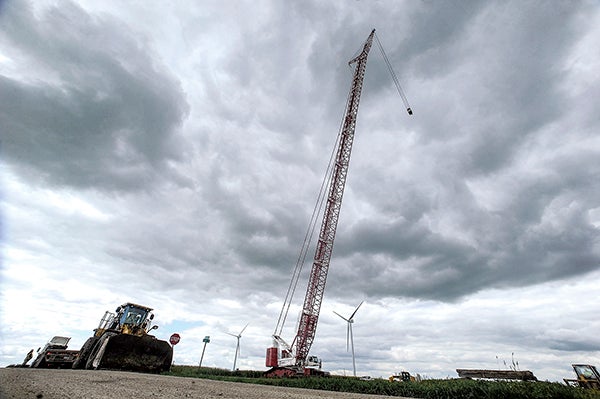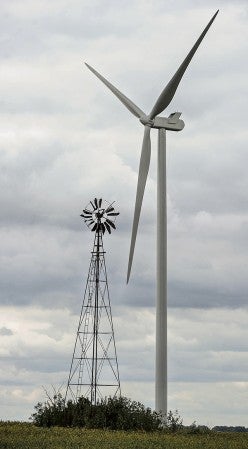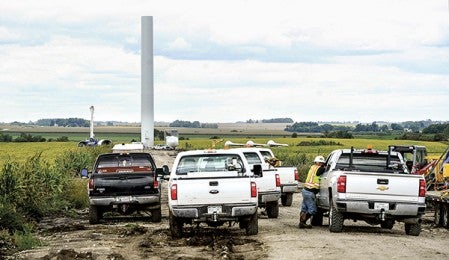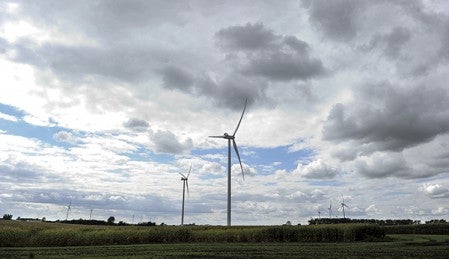Winding Down; Mower’s latest wind farm nearly done despite setbacks from the weather
Published 7:01 am Sunday, September 20, 2015

A 660-ton crane used to assemble wind turbines, crosses a road on the way to another wind turbine site at the Pleasant Valley Wind Farm near Sargeant. Eric Johnson/photodesk@austindailyherald.com
SARGEANT — A few weeks ago, a 660-ton crane inched its way across a rural road northeast of Sargeant above a few feet of soil placed to pad the roadway. Its destination could be seen just a short jaunt away across a soybean field: a partially erected wind turbine with several large components set around its base. It was one of the last turbines needing to be erected in the Pleasant Valley Wind Farm.

A wind turbine from the Pleasant Valley Wind Farm near Sargeant dwarfs a private windmill. Eric Johnson/photodesk@austindailyherald.com
Renewable Energy Systems Americas is nearing completion on the 200-megawatt Pleasant Valley project, despite facing many challenges over the years.
“This job has been a tough job to build, primarily because of the weather,” RES Americas Senior Vice President Chris Hills said. “It’s a very, very important job for us in our portfolio of projects that we’re building, so we’re super excited that we’ve been able to get through the challenges.”
The 100 turbines — 88 in Mower County and 12 in Dodge County — are expected to all be producing energy by the time RES Americas turns over the wind farm to buyer Xcel Energy, which is planned for Oct. 15, according to Hills.
Construction started in 2014 and much of that summer’s work was centered on installing the turbine bases. The turbines began arriving this May and were delivered into August.
But Mother Nature didn’t always cooperate. In late 2014, winter arrived about three weeks earlier than crews expected.
“The amount of construction work we wanted to complete in 2014 was impacted by that,” Hills said. “We basically lost three weeks of construction weather that, based on historical data, we thought we would get.”
While RES ended up doing some cabling work into the winter, much of that work got pushed to this year, which compressed the 2015 workload.
This year held its challenges too, as crews erected the turbines and have been putting them online. RES had to work around road restrictions in the spring and had to wait for the ground to thaw after winter.
This year has also seen more than 40 days where the RES crews couldn’t complete any turbine erection work due to high winds, lightning and an estimated 26 to 30 inches of rain.
“That’s been our biggest challenge this year,” Hills said of the weather.
Typically, erection work is hampered when winds reach about 22 mph or higher, and the winds can be higher 400-feet in the air; however, wind direction and gust speeds also play a key role.
But despite the setbacks, Hills is excited that the project is coming in on time. As of last weekend, 90 of the 100 turbines were erected and all the components had been delivered. RES should be finishing work on erecting turbines any day.
Though many of the turbines are already energized, commissioned and producing energy, RES will now work to commission the remaining turbines.
A long time coming
Setbacks aren’t new to the Pleasant Valley project.

Workers on site at a wind turbine to be assembled wait for the crane to move from another turbine site northeast of Sargeant. Eric Johnson/photodesk@austindailyherald.com
In fact, RES Americas first got the green light to start construction on the project — then pegged as a 300-MW wind farm — in 2010.
However, the project was one of many other pending wind farms in the U.S. that stalled because of uncertainty about whether Congress would renew the federal wind production tax credit — a key subsidy for wind energy — before it expired Dec. 31, 2012.
Congress eventually passed an extension of the 2.2 cent-per-kilowatt-hour tax credit, and then Xcel Energy announced plans in July 2013 to buy the wind farm once RES Americas completed construction.
The Mower County board then approved conditional use permits for the project’s transmission line and substation on March 10, 2014.
Hills said Pleasant Valley has been an important project for the company.
“It’s been one of our flagship construction projects for the 2014-15 years,” he said.
RES completes a lot of the engineering and design work and performs much of the construction on its projects, as Hills said RES is like a one-stop-shop for wind farms, though its services can vary based on buyers’ needs. The company often sells its wind farms upon completion, just like Pleasant Valley is being sold to Xcel.
RES Americas’ parent company, Renewable Energy Systems, is based in Kings Langley, England, but RES Americas’ U.S. headquarters is Broomfield, Colorado, with several other offices around the country, including Minneapolis.
Hills estimated RES constructs about 800 to 1,000 MW of new projects each year — four to five projects the size of Pleasant Valley.
Winding down
Once the turbines are finished and are all commissioned in October, there’s still much work to be done. That’s when the restoration and reclamation phase of the project will kick into gear. Crews will restore the land, put top soil back on the land, and they’ll repair roads. The county has an extensive agreement with RES Americas to restore roads damaged or worn during construction. The temporary RES project offices on the west edge of Sargeant will also be removed and restored.
“Our intention is to make it like we were never here,” Hills said.
Some of the reclamation work has already started on the south half of the project.
“We’d really like to have all of it done before winter stops us from working this year,” Hills said. “That’s certainly our target and our intention, and we’re going to work very hard toward that.”
Hills said they want to leave behind a project with minimal footprint that won’t impede on farmers’ land.
“We recognize that they’ve had to deal with a lot of disturbance and disruption over the last 18 months, and one of our obligations is to minimize that to the greatest extent we can going forward,” Hills said.
Despite the challenges the project and much work still to be completed, Hills praised his RES crews for getting the project done on time.
“Come Oct. 15, I think we’ll be extremely happy to have all the turbines running and I think we’ll be very proud of it,” he said.

Windtowers poke up over fields near Sargeant where the latest area wind farm is being finished up. Eric Johnson/photodesk@austindailyherald.com
Pleasant Valley by the numbers
The task of building a 100-tower wind farm is immense and the materials needed are no less daunting. The numbers to the left detail how much was needed to bring the Pleasant Valley Wind Farm to life, along with a few details on the wind farm moving forward.
100: Number of turbines in the project with 88 in Mower County and 12 in Dodge County
478 feet: Height of the turbines when the blade is at its highest point.
311 feet: Rough height of the turbine’s nacelle.
200,000 pounds: Estimated weight of the nacelles.
660 tons: Size of the clasp crawler crane with 370 feet of boom used to erect the towers and the nacelles. During the project’s peak, there were few of the cranes on site.
500,000: Estimated number of manhours put into the project.
1,300: Estimated number of employees who’ve worked on the project since it began.
400: Estimated number of people working during the project’s peak. Though 1,300 people have worked on the project since it began last year, including about 400 at the project’s peak, RES Americas Senior Vice President Chris Hills said he’s always surprised to drive around the site area and not see many people, since the project is so spread out.
15: Estimated number of permanent jobs after construction for maintenance and upkeep of turbines. The new jobs are expected to be merged into Xcel Energy’s existing operations and hub that already maintains an existing wind farm in Mower County.
9: Number of trucks it takes to deliver the main components of a turbine. About eight of those are oversized, heavy load trucks. That means 900 to 1,000 truck loads were used to deliver turbines when counting smaller turbine components; however, that doesn’t include trucks hauling gravel, cement, wiring and other project equipment. Most of the turbine parts and other equipment were shipped by rail from Vestes facilities in Colorado to Manly, Iowa, and then trucked the remaining distance to the project site. Other parts were shipped from China through Duluth and then they came by rail from there.
27 miles: Length of new access roads built in the project to access turbines.
40,000 cubic yards: Amount of concrete, which was produced in a temporary concrete production farm on site.
3,000-plus tons: Amount of steel reinforcement was used in the turbine foundations.
5 miles: Length of a new transmission line from the Pleasant Valley site to Great River Energy.
80 miles: Estimated distance of trenches excavated to install underground cabling.
2: The number of 300,000-pound power transformers at the new substation.
$7-$8 million: Estimated amount of money spent in the community through things like room and board, fuel, gravel, assorted materials and workers spending money at grocery stores and businesses.
100,000 pounds: Estimated number of waste materials recycled during the project through the RES recycling program
341: The number of Mower County wind turbines once the 88 in this project are completed.
$400,000: Amount of estimated additional money Mower County could get each year through the State Wind Energy Production Tax from Pleasant Valley. Currently, the county received about $1.2 million this year through the credit. However, the county won’t receive the money until after the first year Pleasant Valley is in production, since it’s based on the amount of energy produced the prior year. The money goes into the county’s general budget.



